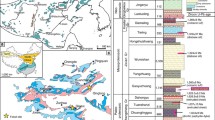Abstract
The Mesoproterozoic Lakhanda Group (~1030 Ma) preserves one of the most diverse communities of pre-Ediacaran eukaryotes. More precisely, the Lakhanda Biota includes more than twenty taxa that have been assigned to eukaryotes with different degrees of confidence. Eight of these taxa meet current criteria for the identification of eukaryotic fossils in ancient records. These include previously described fossils such as ornamented acritarchs (Valeria lophostriata, Trachyhystrichosphaera aimika), filamentous coenocytic organisms (Aimonema ramosa, Palaeovaucheria clavata), as well as fossils with smooth-walled envelopes and single outgrowth structures (Caudosphaera expansa, Germinosphaera bispinosa, and Jacutianema solubila). In addition to these, we found as yet undescribed fossils which share remarkable similarities with Ourasphaira giraldae, a possible higher fungi species known from the (?) Meso- to Neoproterozoic of Arctic Canada. Regardless of the exact systematic affinity, these fossils can confidently be assigned to eukaryotes because of the size and high morphological complexity. Intriguingly, the organic record of the Lakhanda Formation lacks biomarkers indicative of eukaryotes (that is, regular steranes). This finding would be in line with the idea that eukaryotes were present but not significant in Mesoproterozoic marine ecosystems. However, preliminary data from an ongoing study indicate an advanced thermal maturity of the organic matter, emphasizing that this conclusion might not be drawn with absolute confidence.



Similar content being viewed by others
REFERENCES
Butterfield, N.J., Palaeontology, 2015, vol. 58, pp. 5–17.
Javaux, E.J. and Lepot, K., Earth-Sci. Rev., 2018, vol. 176, pp. 68–86.
Loron, C.C., Francois, C., Rainbird, R.H., et al., Nature, 2019, vol. 570, no. 7760, pp. 232–235.
Tang, Q., Pang, K., Yuan, X.L., and Xiao, S.H., Nature Ecol. Evol., 2020, vol. 4, no. 4, pp. 543–559.
Wood, R., Emerg. Top. Life Sci., 2018, vol. 2, no. 2, pp. 201–212.
Love, G.D. and Zumberge, J.A., in Proterozoic Lipid Biomarker Records, Cambridge: Cambridge University Press, 2021, pp. 1–95.
Yankauskas, T.V., Mikhailova, N.S., German, T.N., et al., Mikrofossilii dokembriya SSSR (Microfossils of the Precambrian of the Soviet Union), Leningrad: Nauka, 1989.
German, T.N. and Podkovyrov, V.N., Paleontol. Zh., 2010, no. 4. S, pp. 15–23.
Shuvalova, Yu.V., Nagovitsin, K.E., and Parkhaev, P.Yu., Dokl. Biol. Sci., 2021, vol. 496, pp. 34–40.
Javaux, E.J., Knoll, A.H., and Walter, M.R., Orig. Life. Evol. Biosph., 2003, vol. 33, no. 1, pp. 75–94.
Kampfer, P., Parkes, L., van Keulen, G., and Dyson, P., in The Prokaryotes: Actinobacteria, Berlin: Springer:, 2014, pp. 889–1010.
Shimkets, L.J., Dworkin, M., and Reichenbach, H., in The Prokaryotes, vol. 7: Proteobacteria: Delta, Epsilon Subclass, New York: Springer, 2006, pp. 31–115.
Grilione, P.L. and Pangborn, J., J. Bacteriol., 1975, vol. 124, no. 3, pp. 1558–1565.
Tell, G., Darwiniana, 1970, vol. 16, nos. 1–2, pp. 139–143.
Longcore, J., Mycologia, 1995, vol. 87, pp. 25–33.
An, J.W., Kang, P.J., and Nam, K.W., J. Appl. Phycol., 2020, vol. 32, no. 4, pp. 2689–2696.
Pawlowska, M.M., Butterfield, N.J., and Brocks, J.J., Geology, 2013, vol. 41, no. 2, pp. 103–106.
Knoll, A.H., Summons, R.E., Waldbauer, J.R., and Zumberge, J.E., in Evolution of Primary Producers in the Sea, Cambridge: Academic Press, 2007, pp. 133–163.
Funding
The research was supported by the Russian Foundation for Basic Research (project no. 17-54-12077), the German Research Foundation (DFG) (project nos. DU 1450/4-1 and DU 1450/5-1).
Author information
Authors and Affiliations
Corresponding author
Rights and permissions
About this article
Cite this article
Shuvalova, J.V., Nagovitsin, K.E., Duda, JP. et al. Early Eukaryotes in the Lakhanda Biota (Mesoproterozoic, Southeastern Siberia)—Morphological and Geochemical Evidence. Dokl Biol Sci 500, 127–132 (2021). https://doi.org/10.1134/S0012496621050100
Received:
Revised:
Accepted:
Published:
Issue Date:
DOI: https://doi.org/10.1134/S0012496621050100




